
The Shepherds in the meadows throughout Carcassonne wait peacefully until their entire flock of sheep gathers around. However, they have to be careful that no wolf shows up before they have led their flock safely into the stable.
In the hills, you can take control of lands once thought lost. In addition, many a monk is always happy to have a vineyard near his cloister.
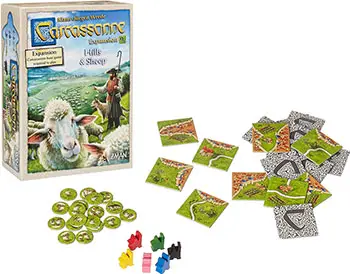
Game Materials
- 18 new Land Tiles
- 18 Sheep and Wolf Tokens
- 1 Cloth Bag
- 6 Shepherds
- Instructions
Setup
The sheep and wolf tokens are all placed in the bag. Each player will also receive one shepherd of his color, to add to his followers.
The new land tiles are mixed in with the others. With the exception of the new rules used with this expansion, all basic Carcassonne rules remain unchanged.
Shepherd and Sheep
Shepherd use: If a player plays a land tile containing a field segment, he can decide whether to deploy a follower to the tile as usual, or he may deploy his shepherd to the field segment instead.
If he deploys the shepherd, he immediately draws a token from the bag. If he draws a sheep token, he places it near his shepherd on the field. If a wolf token is drawn, it is put back into the bag and the shepherd returns to the player's supply.
If the field extended by the newly-placed tile already contains a farmer, the player may still deploy his shepherd to that field, but he may not deploy his shepherd to a field already containing another shepherd.
Expanding a flock of sheep: When a player extends a field containing his shepherd by placement of a new tile, he may first place a follower according to the usual rules of placement, and then he may choose between the following two special actions:
- Expand the flock (by drawing another token from the bag) OR
- Herd the flock into the stable (sheep tokens are scored)
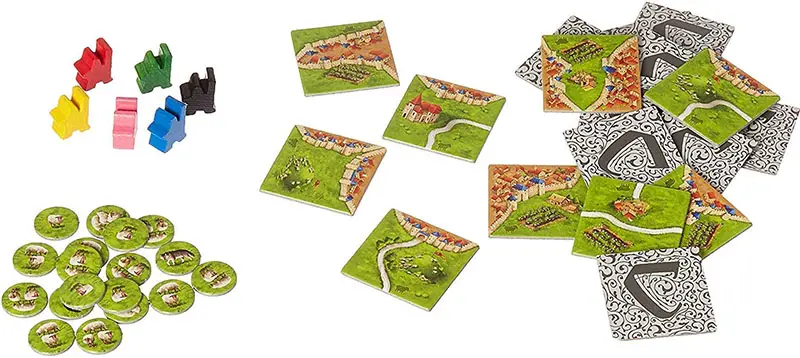
Expand the Flock
The player draws one token from the bag. There are now two possibilities:
-
A sheep token is drawn - The flock continues to expand. The player places the sheep token with the other(s) near his shepherd.
-
A wolf token is drawn - The wolf chases the sheep away! The player must now return all sheep tokens from the field to the bag (along with the wolf token), and returns the shepherd to his supply without scoring.
Herd the Flock Into the Stable
Instead of drawing a new token from the bag, the player can decide to score his shepherd's flock. For every sheep pictured on the tokens that have accumulated in his field, he scores 1 point (the tokens are valued from 1 to 4 points).
After scoring, the player returns all sheep tokens from the field to the bag, and returns the shepherd to his supply.
More Than One Shepherd in a Field:
By the subsequent joining of originally separate fields, more than one shepherd may be present in the same field. If this happens, all sheep in the newly-connected field are considered to be part of the same flock, and (if scored) will earn points for every shepherd in that field.
Whenever a sheep token is added to a flock in this case, it will essentially score the same for every shepherd. If one of the shepherds decides to score his flock, all shepherds in that field score the same points (the total of all sheep on all tokens in that field), and all concerned players must return their sheep tokens to the bag and return the shepherds to their supply.
If a player draws a wolf token from the bag, the flock is lost for all shepherds in that field. All sheep tokens in the entire field are returned to the bag (along with the wolf token), and all shepherds in that field are returned to players' supplies without scoring.
The Shepherd Is Not a Follower.
A player who wishes to score his shepherd must do so by using the "Herd the flock into the stable" action. The shepherd is not influenced by any other game scoring, and also does not influence any other game scoring.

Example: The Red and Blue shepherds are both standing in the same field.
There are 4 sheep tokens in the combined flock with a total of 8 sheep. On Red's turn, he extends the field and decides to score the sheep.
Red and Blue both score 8 points. All of the sheep are put back into the bag, and both players return the shepherds to their supply.
If Red had decided to expand the flock and had drawn a wolf token, no points would have been scored by either player.

If any shepherds with their sheep are still present in fields at the end of the game, they do NOT score.
Hills


Place and occupy: If a player draws a land tile depicting a Hill, he immediately draws a second tile, keeping it face-down, and places it under the Hill tile without looking at the second tile.
Then, according to the normal rules of placement, he places the two-tile-high Hill and may deploy a follower on it. Other than its increased height, any other features depicted on the Hill tile (city, road, and field) function as they do in the basic game.
Scoring effects of a Hill: When scoring a region (city, road and field) with more than one follower, a follower on a Hill breaks any ties in favor of the owner of that follower.
The player with a follower on a Hill receives all of the points for that region. In this case, any other players involved in the tie who do not have a follower on a Hill receive no points for the region.
If there is no tie, a follower on a Hill has no additional special meaning. Followers on Hills are returned to a player's supply as usual after a scoring.
These Hill rules also apply to the final scoring at the end of the game.
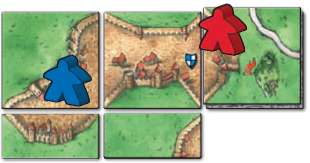
Example: Example: Red and Blue each have 1 knight in the city when it is completed. The Red knight stands on a Hill in the city. Therefore, Red wins the tie and scores 10 points. Blue earns no points.
Vineyards

Placement: A land tile depicting a Vineyard is placed according to the usual rules. Whenever a cloister is completed and scored, the owner receives 3 additional points for every Vineyard on any of the 8 land tiles surrounding the cloister.
A Vineyard may contribute to the additional points of multiple cloisters.
If any cloisters remain incomplete at the end of the game, any surrounding Vineyards will score no additional points.
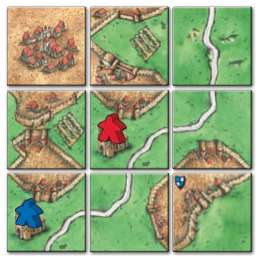
Example: Red has just completed a cloister, which is now scored.
There are two Vineyards surrounding this closter. Therefore, Red scores 9 + 3 + 3 = 15 points.
If Blue's cloister is completed later in the game, he will also receive 3 additional points from the Vineyard on the land tile directly above the cloister.
New Land Tiles
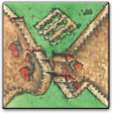
The field regions between the two cities are not connected.
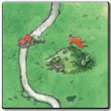
The cottages divide the road into 2 parts (end segments).
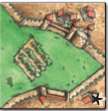
The right side of this tile is a "city side" with two separate city segments. If a tile with a city segment is placed next to it, the two segments are then connected.

Example: The tie on the right connects the two formerly separate city segments of the tiie on the ieft.
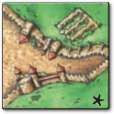
The right side of this tile is a "field side" with two separate field segments. If a tile with a field segment is placed next to it, the two field segments are then connected.

Example: The tile on the right connects the two formeriy separate fieid segments of the tiie on the ieft.
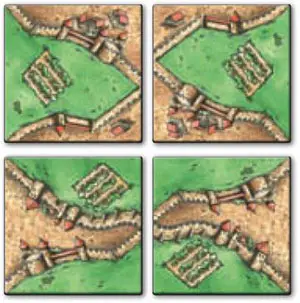
Special case: If these two particular tiles are placed next to each other as shown, all four formerly separate city segments are then connected into 1 city. (These tiles are intentionally created asymmetrically).
Special case: If these two particular tiles are placed next to each other as shown, the two city segments are not considered to be connected. In addition, the top and bottom field segments are not considered to be connected.
Special rules for "The Princess and the Dragon" expansion: If the dragon moves to a land tile containing a shepherd (with his sheep tokens), the dragon eats the shepherd and all of his sheep.
The player returns the shepherd to his supply and places the sheep tokens back into the bag. Note that this is an exception to the rule that states that the dragon only eats followers. The sheep (and shepherd) simply look too delicious to the dragon, and unfortunately, he can no longer distinguish...
Continue Reading


